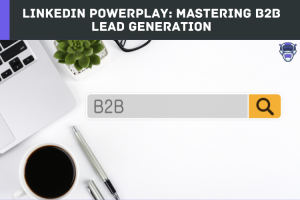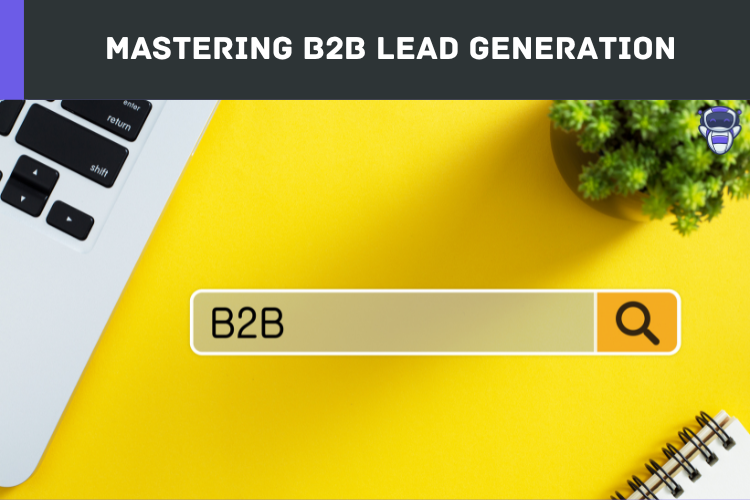Learn how to generate leads through LinkedIn and close more sales with powerful lead capture tactics. You’ll be able to identify your target market, create compelling content, and track your progress.

LinkedIn has emerged as a powerhouse platform for B2B lead generation, offering unparalleled opportunities to connect with decision-makers, build valuable relationships, and generate high-quality leads. However, harnessing the true potential of LinkedIn requires a strategic and systematic approach. This guide, “LinkedIn PowerPlay: Mastering B2B Lead Generation,” is designed to equip you with the knowledge and tactics needed to excel in leveraging LinkedIn for B2B lead generation.
By mastering LinkedIn’s features and implementing proven B2B lead generation strategies, you will be able to position yourself as an industry authority, expand your network of relevant connections, and generate a consistent stream of qualified leads. Whether your goal is to drive sales, build partnerships, or establish thought leadership, LinkedIn can be your most valuable ally in achieving those objectives.
So, get ready to elevate your LinkedIn game and unleash its power for B2B lead generation. Let’s dive in and discover the strategies that will enable you to master the art of leveraging LinkedIn for unparalleled business growth.
Contents
Importance of Mastering LinkedIn for Effective B2B Lead Generation
The importance of mastering LinkedIn for effective B2B lead generation cannot be overstated. LinkedIn has established itself as the leading professional networking platform, with over 740 million members worldwide, making it an invaluable resource for businesses seeking to connect with decision-makers, industry professionals, and potential clients. Here’s why mastering LinkedIn is crucial for B2B lead generation:
-
Access to a Targeted Audience
LinkedIn is a hub of professionals from various industries and sectors, providing a vast pool of potential leads who are actively engaged in professional networking. By understanding how to navigate and leverage LinkedIn effectively, you gain access to a highly targeted audience of individuals who are more likely to be interested in your products or services.
-
Relationship Building and Trust
B2B lead generation is not just about acquiring contacts; it’s about establishing meaningful relationships. LinkedIn offers a platform for fostering genuine connections, engaging in industry-related discussions, and showcasing your expertise. By mastering LinkedIn, you can build trust, credibility, and rapport with potential leads, increasing the chances of converting them into long-term business relationships.
-
Comprehensive Company and Individual Insights
LinkedIn provides valuable company and individual profiles, giving you access to a wealth of information about your prospects. By mastering LinkedIn’s advanced search filters and research capabilities, you can gather insights about a company’s size, industry, key decision-makers, and even their recent activities. This information enables you to tailor your approach and engage in more personalized conversations, increasing the likelihood of generating quality leads.
-
Content Distribution and Thought Leadership
LinkedIn offers multiple avenues for content distribution, allowing you to establish yourself as a thought leader within your industry. By creating and sharing insightful content, such as articles, posts, and videos, you can demonstrate your expertise, attract the attention of potential leads, and nurture relationships with them. Mastering LinkedIn’s content strategy enables you to position yourself as a trusted authority, making it easier to generate leads.
-
Proactive Outreach and Engagement
LinkedIn provides various communication channels, including connection requests, InMail, and commenting features, that allow you to proactively reach out to potential leads. By mastering the art of personalized messaging and engaging in relevant conversations, you can initiate meaningful interactions, demonstrate your value proposition, and move prospects further down the sales funnel.
-
Data-driven Insights and Analytics
LinkedIn offers powerful analytics tools that allow you to track the performance of your lead generation efforts. By mastering LinkedIn’s analytics, you can measure key metrics, such as profile views, engagement rates, and conversion rates, to gain valuable insights into the effectiveness of your strategies. This data empowers you to refine and optimize your approach, ensuring continuous improvement and better results over time.
Building a Strong Foundation for Better B2B Lead Generation
Building a strong foundation on LinkedIn is essential for effective B2B lead generation. It involves optimizing your profile, growing a relevant network of connections, and establishing yourself as a credible professional within your industry. Here are key steps to lay a solid foundation on LinkedIn:
1. Optimize Your Profile
- Profile Picture and Headline: Use a professional and high-quality profile picture that represents your personal brand. Craft a compelling headline that clearly communicates your expertise and value proposition.
- Summary and Experience Sections: Write a concise and engaging summary that highlights your key skills, experiences, and accomplishments. In the experience section, outline your relevant work history and responsibilities.
- Showcase Skills, Certifications, and Recommendations: Add relevant skills to your profile, as they serve as keywords for search optimization. Include any relevant certifications or qualifications. Seek recommendations from colleagues or clients to enhance your credibility.
2. Grow a Relevant Network
- Identify Target Prospects: Determine your ideal target audience and create a list of professionals you want to connect with on LinkedIn.
- Engage with Industry Influencers: Follow and engage with thought leaders and industry influencers in your niche. Interacting with their content and participating in relevant discussions can help expand your network.
- Leverage Existing Networks: Connect with colleagues, classmates, clients, and partners to establish a strong foundation. Utilize LinkedIn’s “People You May Know” feature to discover and connect with relevant professionals.
3. Establish Thought Leadership
- Share Valuable Content: Create and share insightful and relevant content, such as articles, posts, and industry updates. Position yourself as a thought leader by providing valuable insights and solutions to common industry challenges.
- Engage in Discussions: Participate in industry-related groups and discussions. Offer valuable input, share your expertise, and contribute to meaningful conversations. This helps you build credibility and visibility within your professional community.
- Publish Long-Form Content: Utilize LinkedIn’s publishing platform to write long-form articles that demonstrate your expertise. Share in-depth insights, case studies, and actionable advice to establish yourself as a trusted authority.
4. Engage with Your Network
- Regularly Interact with Connections: Engage your connections by liking, commenting, and sharing their posts. This helps foster relationships and keeps you top of your mind.
- Personalized Connection Requests: When sending connection requests, personalize the message and highlight the mutual benefit of connecting. Avoid generic requests.
- Respond to Messages and Inquiries: Promptly respond to messages, connection requests, and inquiries. Engage in meaningful conversations and follow up with potential leads to nurture relationships.
Proactive Outreach and Engagement

Proactive outreach and engagement are key components of successful B2B lead generation on LinkedIn. By reaching out to potential leads and actively engaging with your network, you can initiate meaningful conversations, demonstrate value, and nurture relationships. Here are some strategies for proactive outreach and engagement on LinkedIn:
1. Personalized Connection Requests
- Research and Target: Before sending a connection request, research the individual to understand their background and interests. Tailor your request to highlight shared interests, mutual connections, or how you can provide value to them.
- Craft a Compelling Message: Personalize your connection request message to make it more engaging and relevant. Clearly communicate why you’re interested in connecting and how you can potentially benefit each other.
2. Engage with Relevant Content
- Like and Comment: Regularly engage with posts and updates from your connections and target audience. Like their posts to show support and leave thoughtful comments to initiate conversations.
- Share Valuable Insights: Share your expertise and insights by posting relevant articles, industry news, or helpful resources. Provide valuable input and contribute to discussions on other people’s posts.
3. Join and Participate in Groups
- Find Relevant Groups: Identify LinkedIn groups that align with your industry, target audience, or areas of interest. Join these groups to connect with professionals who share similar interests.
- Contribute Meaningfully: Actively participate in group discussions by sharing your expertise, answering questions, and providing valuable insights. Avoid self-promotion and focus on providing value to the community.
4. Utilize LinkedIn Messaging
- Personalize InMail Messages: When reaching out to potential leads via LinkedIn’s InMail feature, customize your messages to demonstrate that you’ve done your research and have a genuine interest in connecting or starting a conversation.
- Follow Up Strategically: After initial interactions or conversations, follow up with personalized messages to continue building relationships. Reference previous discussions or interactions to show your attentiveness.
- Advanced Search and Lead Recommendations: Utilize LinkedIn Sales Navigator to conduct advanced searches and identify potential leads based on specific criteria, such as job titles, industries, or locations. Take advantage of lead recommendations to discover new prospects.
- Save and Track Leads: Save leads and prospects on LinkedIn Sales Navigator to keep them organized and track their activities. This allows you to stay updated on their recent updates and engage with them timely.
6. Be Responsive and Timely
- Respond Promptly: When you receive messages, connection requests, or inquiries, respond in a timely manner to show your professionalism and genuine interest.
- Follow-Up and Nurture Leads: After initial conversations or engagements, follow up with leads to continue the conversation and nurture the relationship. Provide relevant information or resources that demonstrate value.
Conclusion of Mastering LinkedIn for B2B Lead Generation
Mastering LinkedIn for B2B lead generation is a game-changer for businesses looking to connect with decision-makers, build relationships, and generate high-quality leads. By building a strong foundation, engaging in proactive outreach, and leveraging LinkedIn advertising, you can unlock the platform’s full potential and achieve remarkable results.
LinkedIn provides a targeted audience, comprehensive insights, and valuable networking opportunities that can fuel your lead-generation efforts. Through personalized connection requests, engaging with relevant content, and participating in industry discussions, you can establish yourself as a thought leader and nurture valuable relationships with potential leads.


